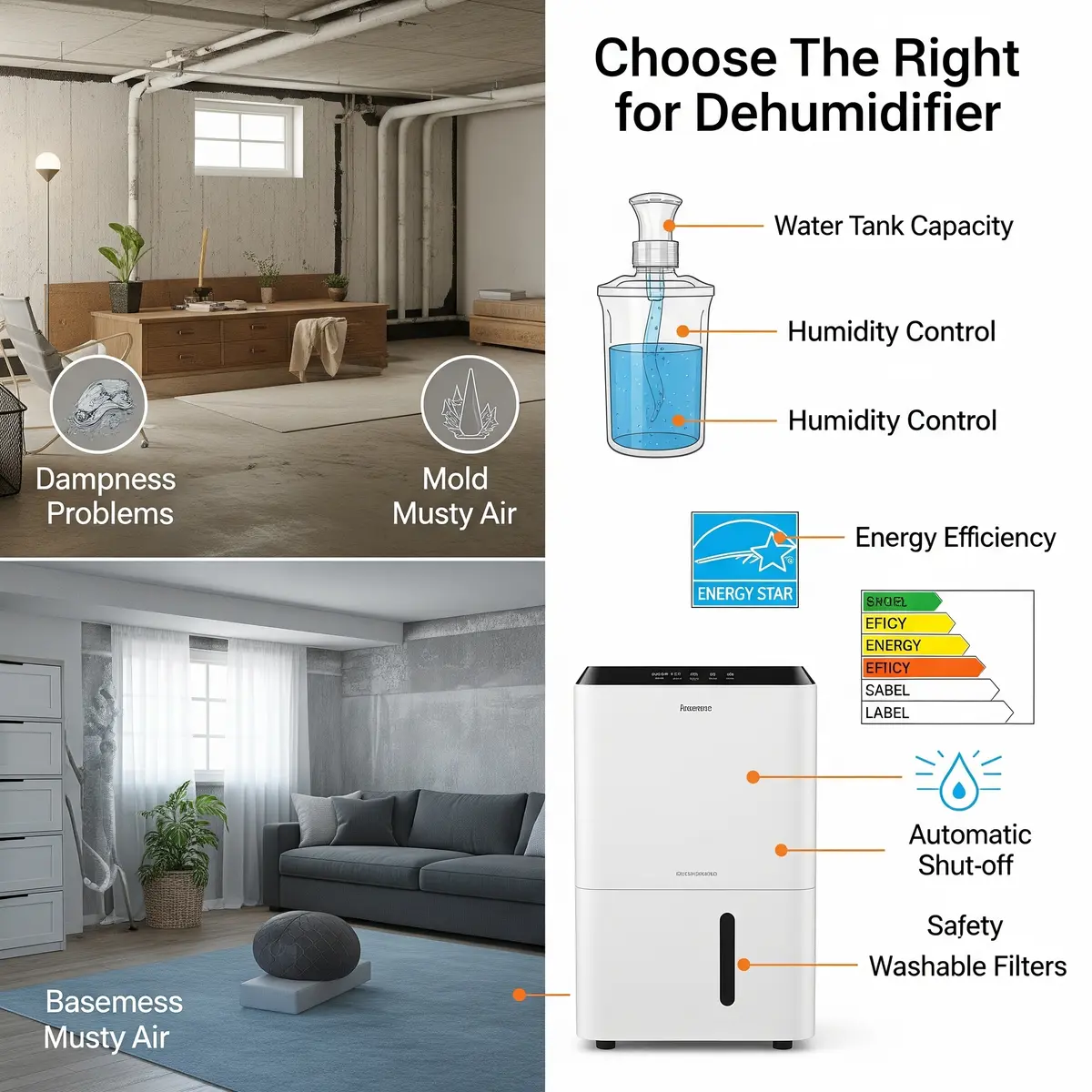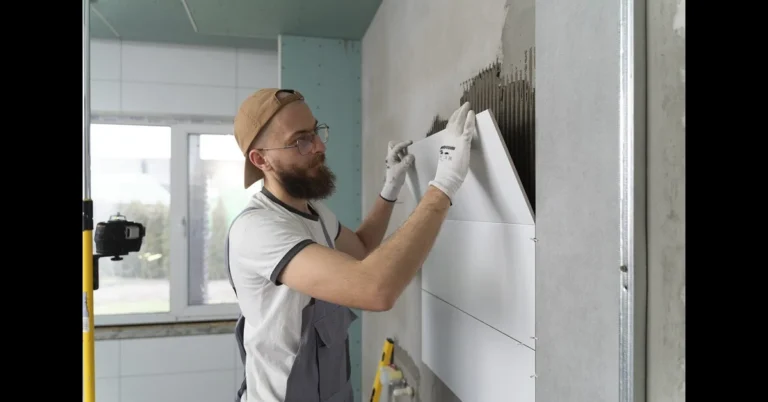Because there are so many dehumidifiers for basements, you could feel a bit lost while shopping for one. There are endless models and features out there, so it’s hard to know which is best for your basement. What counts most is focusing on the features you require the most. That being said, you want a dehumidifier that works well, is easy to take care of, and ensures your basement stays dry and free of mold. dehumidifier buying tips
We’ll go over the top features to look for when selecting a dehumidifier for your basement. No matter if your concern is small dampness or a huge, overly damp basement, these features will guide you toward the best choice.
1. Coverage Area
You should check the coverage area right away when shopping for a dehumidifier for your basement. You will find dehumidifiers with ratings showing how big the area they can manage is. Square footage is usually the main consideration, and your decision should match the size of your basement.
FIND OUT ABOUT CHOOSING THE RIGHT SIZE FOR YOUR BASEMENT
A small basement of less than 500 sq. ft. can be dried with a dehumidifier that handles about 30 to 50 pints a day.
If your basement measures from 500 to 1,500 square feet, choose a machine that can extract 50-70 pints per day.
When your basement is over 1,500 square feet, you need a dehumidifier that removes 70 pints or more of moisture a day.
If you pick the right size, the dehumidifier will work just right for the level of humidity in your basement.
Pro Tip:
If you’re not confident, choose a size that is a bit bigger. A slightly larger dehumidifier will handle the job better and last a longer time than one that’s not suited to the area.
2. How to control and set the humidity
A dehumidifier you can check controls for is essential for the humidity level you want in your basement. Make sure the model you choose allows you to adjust the humidity so it works best for your basement. Some models include a humidistat, so the dehumidifier automatically keeps the air at the desired humidity level.
All you need to know about controlling humidity features is in this section.
A humidistat feature works like a thermostat does for humidity.
If the power fails, this feature restarts the dehumidifier so you don’t have to set the controls again.
In continuous mode, the device runs steadily when it senses high humidity and can only be stopped when you press the power button.
The Reason It Matters:
Keeping your basement humidity level at 50-55% will stop mold growth and make sure the area is comfortable.
3. Energy Efficiency
Since a basement often gets moist, drying out the air with a dehumidifier all day long can cost a lot more in electricity. For this reason, check and selecting a dehumidifier with good energy efficiency matters a great deal for keeping your basement dry. Choose Energy Star-certified units since these models use up to a third less energy than those that aren’t..
What You Need to Keep in Mind When Searching for Energy-Efficient Dehumidifiers
Getting Energy Star: Makes sure the dehumidifier achieves high energy efficiency.
Built-in sensors allow the dehumidifier to only start working when it’s needed, which lowers energy bills.
Pro Tip:
If you will be running the unit all the time, its efficiency allows you to cut costs over time.
4. Drainage Options
This is a particular feature when considering dehumidifiers: removing water is vital. With some models, users have to empty the water themselves, but models with a continuous drain option let the water flow straight to a nearby sink or floor drain.
If you don’t want to empty the tank too often, get a unit that drains continuously. With it, your dehumidifier will be able to work all the time with no gaps in between.
How to Notice Important Aspects of Drainage.
With a built-in drainage hose, water flows straight to a drain, and you do not have to do anything.
When you don’t connect to a drain, ensure the tank is large so it doesn’t often need to be emptied.
Pro Tip:
Although a drainage hose is handy, it’s essential that the hose isn’t blocked so that water can escape properly.
5. Quiet Operation
You don’t want a noisy dehumidifier in your basement, whether you’re working, relaxing, or storing things there. That’s why quiet operation is a crucial requirement for most people. You may be delighted to learn that most dehumidifiers today are built to work quietly due to advanced and efficient technology.
How to Choose a Quiet Dehumidifier. Dehumidifier Buying Tips
Look at the decibel (dB) rating; choose a unit that gives off sound between 40 and 50 decibels.
You can set some dehumidifiers to quiet mode, which lessens both fan speed and any sound.
The benefits of training are explained here.
If the model is quiet, it won’t bother you while you work or rest in the basement.
6. You can Put Them Anywhere
If you need to move your dehumidifier or wish to keep it safe throughout winter, choose a model that’s designed for easy carrying. Many dehumidifiers today include wheels built in, so you can move them easily.
What Points to Consider When Choosing a Portable Dehumidifier:
Providing wheels or handles for the user to make it easy to carry things.
A design that’s simple to move around and stow away.
What Makes It Important:
You can change where a portable dehumidifier is used according to changing weather or humidity in different parts of your basement.
7. Easy-to-Use Controls
It’s best to choose a dehumidifier with simple controls to prevent mold in your basement. Try to get a dehumidifier with a clear digital screen and buttons that you can press with your fingers. Many models have Wi-Fi and special controls, which allow you to manage them remotely from your phone. Help control the humidity of a basement dehumidifier
How to Identify Important Controls for a Game:
A simple interface with understandable indicators for humidity and the settings.
Users can control the camera in different parts of their house through an app.
All you need to do is press or touch a button, with no difficult settings.
Why It Matters: Check in a Dehumidifier for Your Basement
Since using the controls is simple, you don’t have to work hard to get used to operating your dehumidifier when you have to quickly adjust the humidity.
If you pick a suitable dehumidifier, you can make a big difference in keeping your basement dry and mold-free. Taking care of size, humidity, energy, and drainage features will ensure you pick the right complement for your basement. Look at how big the area you want is, how much energy it uses, its drainage system, and how much noise it makes before you decide.
If you have a reliable dehumidifier, you won’t have to worry about mold and mildew in your basement for years.




